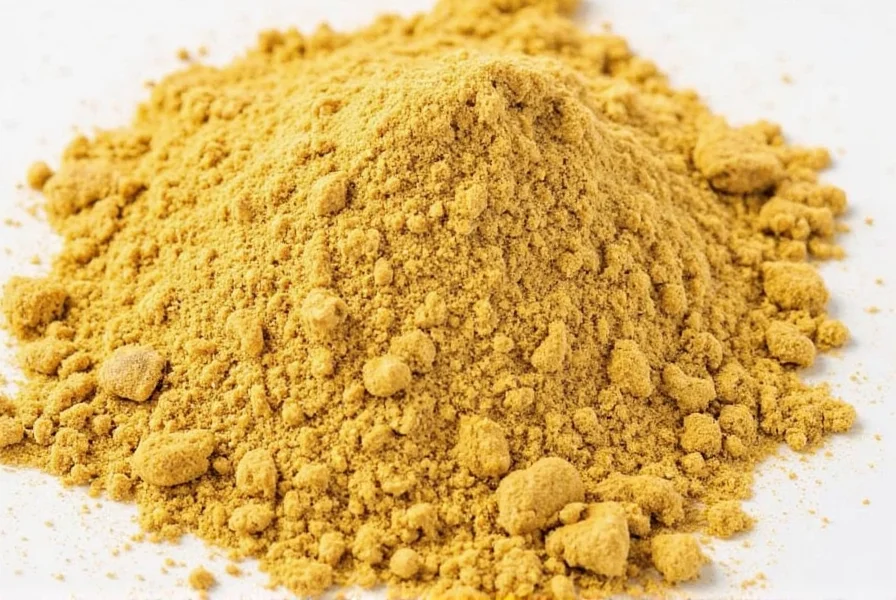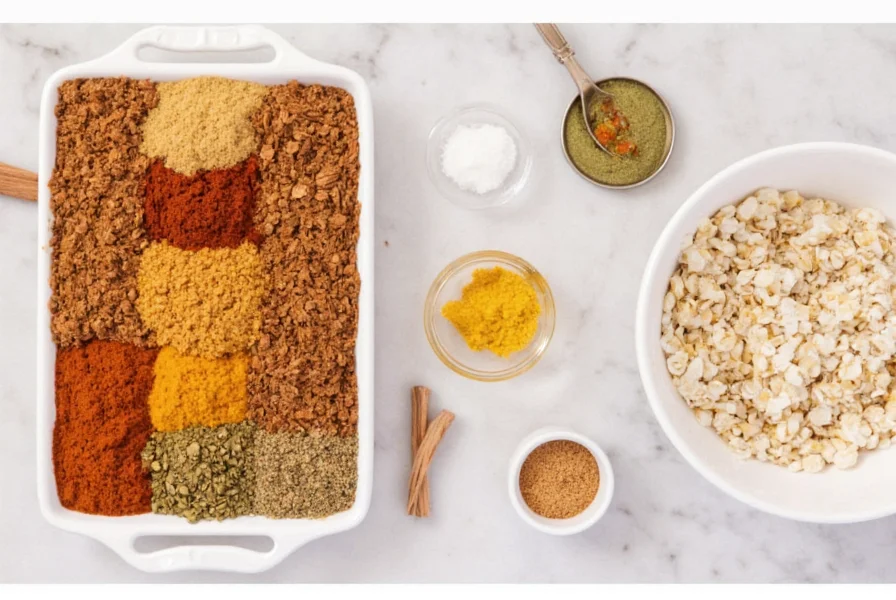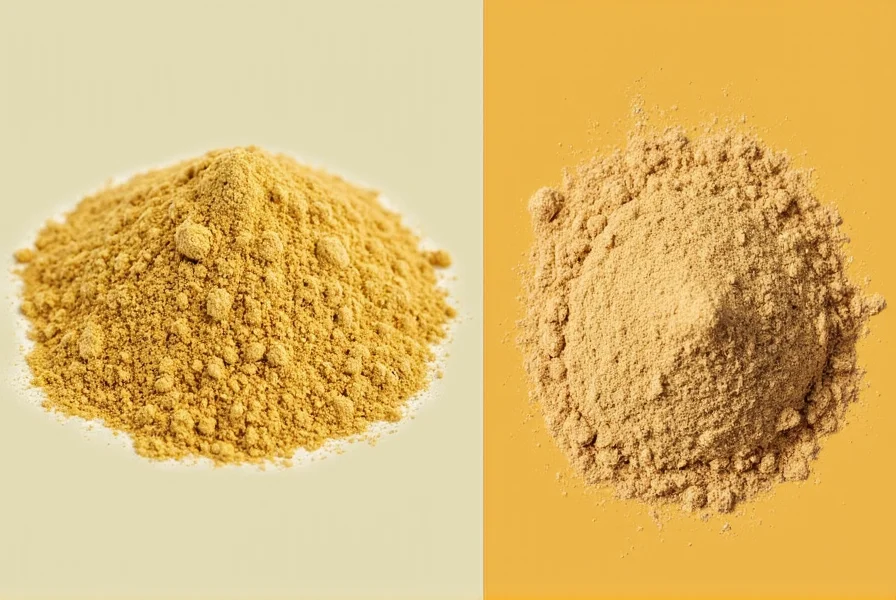Table of Contents
Introduction
Ground ginger and ginger powder are NOT the same thing. While both come from ginger root, they differ in processing, texture, flavor intensity, and best uses. Here's a clear comparison to help you choose the right one for your recipes.

What Is Ground Ginger?
Ground ginger is made by grinding fresh ginger root into a fine powder. It's commonly used in both sweet and savory dishes. The texture is slightly coarser than ginger powder, and it has a more robust, aromatic flavor. Ground ginger is popular in baked goods, marinades, and traditional recipes from various cuisines around the world.

What Is Ginger Powder?
Ginger powder is essentially the same thing as ground ginger—but with one key difference. While ground ginger is made by grinding fresh ginger, ginger powder is often made from dried ginger root that has been processed into a finer consistency. It's more concentrated in flavor and is commonly used in Western baking, such as in gingerbread, cookies, and cakes. It also appears in some Asian recipes but is less frequently used than its fresh counterpart.
Key Differences Between Ground Ginger and Ginger Powder
Although they may seem similar, there are a few important distinctions between ground ginger and ginger powder:
- Texture: Ground ginger tends to be coarser, while ginger powder is finer.
- Flavor Intensity: Ginger powder is more potent and has a stronger, spicier taste compared to ground ginger.
- Usage: Ground ginger is ideal for recipes where you want a milder, more aromatic flavor, while ginger powder is better suited for baked goods and desserts.
- Origin: Ground ginger is often used in Indian, Chinese, and Southeast Asian cuisines, while ginger powder is more common in Western cooking.

Similarities Between Ground Ginger and Ginger Powder
Despite their differences, ground ginger and ginger powder share several similarities:
- Both come from the ginger root. They are derived from the same plant, just processed differently.
- Both add warmth and depth to dishes. Whether you're making a soup, curry, or cookie, both can bring a nice kick of heat and flavor.
- Both are versatile. From drinks to sauces, they can be used in a wide variety of recipes.
Practical Tips for Using Both
Here are some practical tips to help you make the most of both ground ginger and ginger powder in your kitchen:
- Use ground ginger in curries, soups, and stews. Its earthy flavor complements many savory dishes.
- Opt for ginger powder when baking. It's great for adding spice to cookies, breads, and cakes.
- Adjust the amount based on potency. Since ginger powder is stronger, you may need to use less than you would with ground ginger.
- Store properly. Keep both in airtight containers away from light and moisture to preserve their freshness.
- Try both in your next recipe. Experiment with different flavors to find what works best for your palate.
- Substitute correctly: For every 1 teaspoon of ground ginger, use 3/4 teaspoon of ginger powder; for every 1 teaspoon of ginger powder, use 1 1/4 teaspoons of ground ginger.
| Feature | Ground Ginger | Ginger Powder |
|---|---|---|
| Texture | Coarse | Fine |
| Flavor | Mild, aromatic | Strong, spicy |
| Best For | Savory dishes, curries, soups | Baked goods, desserts, Western recipes |
| Availability | Common in Asian and Indian markets | Widely available in supermarkets |
| Price | Average | Average |
If you're an amateur cook who loves experimenting, ground ginger might be the better choice. However, if you're into baking or prefer a more intense flavor, ginger powder could be your go-to.
Some popular brands to consider include:
- McCormick Ground Ginger – Great for everyday cooking and baking.
- Kikkoman Ginger Powder – Known for its quality and consistent flavor.
- Pillsbury Ginger Powder – Ideal for baking and homemade treats.
Frequently Asked Questions
Is ground ginger the same as ginger powder?
No, ground ginger and ginger powder are not exactly the same. While both come from ginger root, they differ in processing, texture, and flavor intensity. Ground ginger is typically made from fresh ginger that's been dried and coarsely ground, while ginger powder is usually made from fully dried ginger root processed into a finer consistency with more concentrated flavor.
Can I substitute ground ginger for ginger powder in recipes?
Yes, but with adjustments. Since ginger powder is more potent, you'll need to use less of it when substituting for ground ginger. As a general rule, use 3/4 teaspoon of ginger powder for every 1 teaspoon of ground ginger called for in a recipe. Conversely, use 1 1/4 teaspoons of ground ginger for every 1 teaspoon of ginger powder.
Which has more health benefits, ground ginger or ginger powder?
Both contain similar nutritional compounds since they come from the same root. However, ground ginger may retain slightly more volatile compounds due to less processing. Both forms contain gingerol, which has anti-inflammatory properties, but the concentration can vary based on processing methods and storage conditions.
How long do ground ginger and ginger powder last?
Both ground ginger and ginger powder typically retain their best flavor for 1-2 years when stored properly in airtight containers away from heat, light, and moisture. While they don't spoil, they gradually lose potency over time. To test freshness, rub a small amount between your fingers - if the aroma is weak, it's time to replace your supply.
Can I make my own ground ginger or ginger powder at home?
Yes! To make your own, peel fresh ginger, slice it thinly, and dry it completely (using a dehydrator or low oven). Once fully dried and brittle, grind it in a spice grinder or blender until you reach your desired consistency. For ground ginger, stop when it's slightly coarse; for ginger powder, continue until fine. Store in an airtight container away from light.
Conclusion
In conclusion, is ground ginger the same as ginger powder? The short answer is no—they are similar but not identical. While both come from the same root, they differ in texture, flavor intensity, and ideal use cases. Understanding these differences can help you choose the right option for your recipe and elevate your cooking game.
Whether you're using ground ginger in a rich, savory stew or ginger powder in a moist gingerbread, each has its place in the kitchen. So next time you reach for your spice rack, take a moment to think about which one fits your dish best.

Remember, the best way to learn is by experimenting. Try both types of ginger in your favorite recipes and see which one brings out the flavor you love the most. Happy cooking!










 浙公网安备
33010002000092号
浙公网安备
33010002000092号 浙B2-20120091-4
浙B2-20120091-4